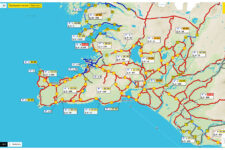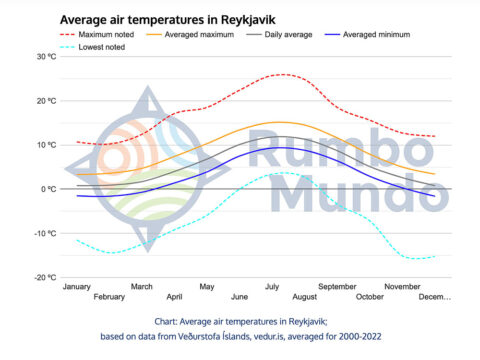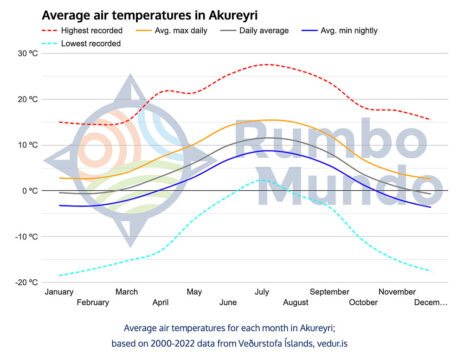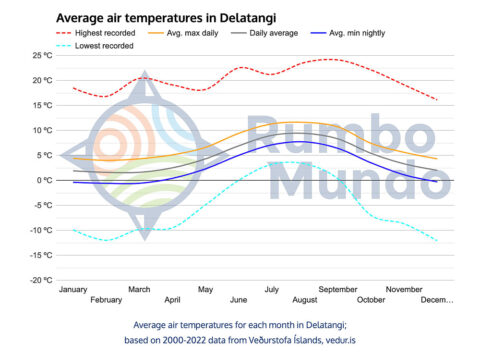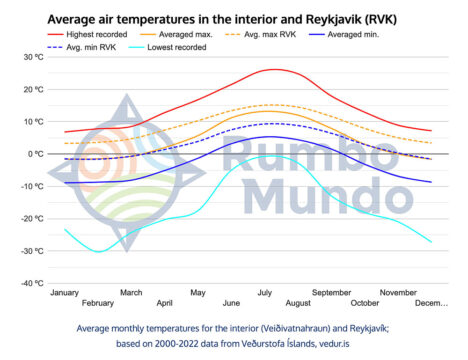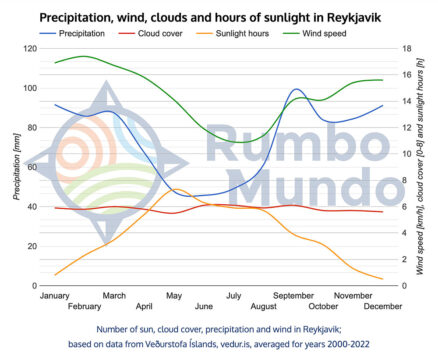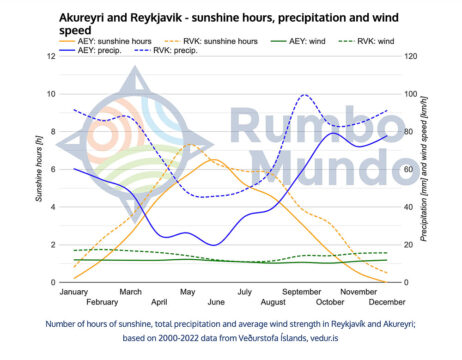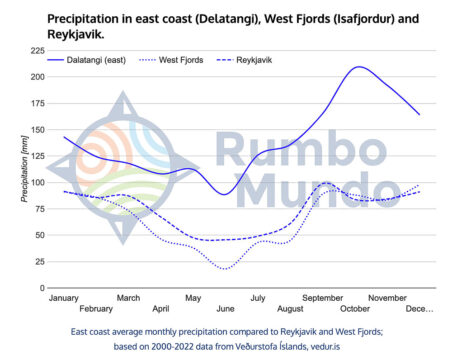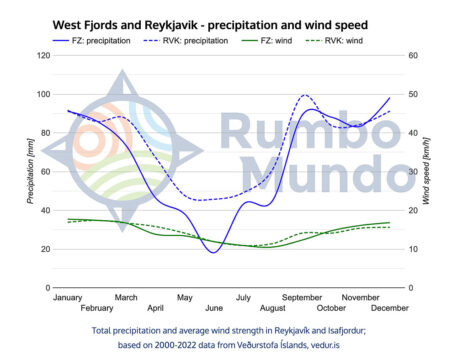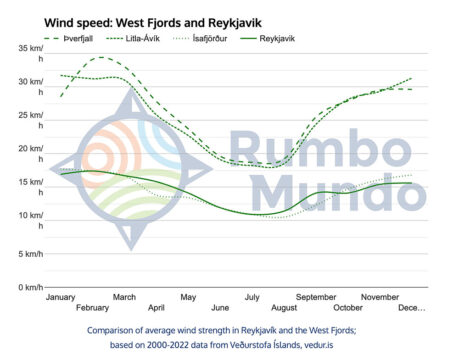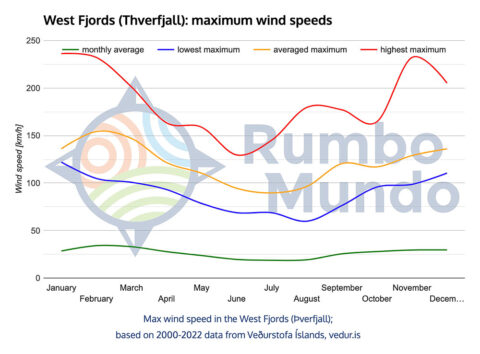Iceland’s climate has been riddled with a lot of myths and misconceptions. Therefore, accurately and practically, based on the best statistical data and our own experience, we describe what kind of weather to expect when coming to this beautiful island.
Iceland weather – READ THIS FIRST
Iceland is actually a small island located in the middle of the vast and cool Atlantic. Therefore, regardless of the season, its weather always has several distinctive features. Here are the most important basic features of Iceland’s year-round weather:
- Anything can happen
Regardless of the weather typical for a particular season or month, Iceland can quite easily experience storms and several days of completely extreme weather (please see the ‘storms and natural disasters‘ section below). For example, the average daytime temperature in May is 10.3 °C (50.5 °F) and more than half (56%) of May days actually have a maximum daytime temperature close to this average – between 8 °C and 12 °C (46 – 54 °F). But the warmest day recorded as much as 18.5 °C (65.3 °F; May 9, 2006), and the coldest only 1.9 °C (35.4 °F; May 1, 2013). The coldest May night had a temperature of -5.9 °C (21.4 °F). “Expect the unexpected,” one might say…
- Cold weather is year-round
Although winters are mild – the average daily temperature in January is 3.3 °C, but as it is in a maritime climate, summers are also “perennial.” The daily temperature exceeds 15 °C (59 °F) only in July, and that really symbolically – it is exactly 15.1 °C (59.2 °F). Thus, winter (in this respect) is quite mild, but summers are rather cold.
A
ccording to classical climatic definitions of the seasons, winter is the period in which the average daily air temperature falls below 0 °C (32 °F), and summer is the period in which the average daily air temperature exceeds 15 °C (59 °F). [Source:
Wikipedia – winter,
Wikipedia – summer]. In this sense,
in Iceland there is neither winter nor summer – all year round there is such a specific spring and autumn…
- It always blows hard
The impression of year-round cold is compounded in Iceland by strong winds. In the windiest regions, there has yet to be (at least since 2000) a winter without winds above 100 km/h (62 mph). Particularly windy are the West Fjords and the interior, but also in Reykjavik and on the southern coast the strong wind is a constant visitor at any time of the year.
- Days are not much warmer than nights
Strong winds, high cloud cover, direct proximity to the cold ocean, and a location just below the Arctic Circle, mean that the sun is unable to warm the air even in summer, when the day lasts more than 20 hours. The minimum night temperature and maximum daytime temperature on average differ by no more than 6 °C. Therefore, it rarely happens here as it does in the spring in Poland – that although the morning is cool, it gets really warm during the day. Usually the morning is cool, but during the day it is also cool…
- Summer is the least rainy season
Unlike mainland Europe, Iceland records its lowest rainfall in early summer – from May to July. Monthly precipitation totals are then up to half that of September to March. Unfortunately, also in summer, precipitation tends to be in the form of prolonged drizzle or light rain rather than a concentrated 15-minute downpour. So it’s hard to get completely soaked, but it’s also hard to wait out the rain.
- Regional differences are relatively minor
Iceland is a small island, so the statistical differences between its different parts are not small. Prominent are the central highlands, known as the interiors, which are noticeably cooler and windier than most of the country. To some extent, they are matched by the far northwestern West Fjords. These regions also have the longest snowfall. Eastern Iceland is the rainiest, while the south has the relatively mildest climate.
- There is a fairly pronounced warming of the climate
Comparing the data for 1977-1999 and 2000-2022, it is clear that Iceland has gotten noticeably warmer and less windy. The average maximum daytime temperature has risen for some months by as much as 2 °C, and the lowest nighttime temperature is now as much as 5.5 °C higher! The average wind speed, meanwhile, has dropped by as much as 30%. So in a sense, Iceland’s weather has become friendlier, but as all the guides confirm, for example, the glaciers are retreating extremely fast.
- Weather is also created by volcanoes and glaciers
An additional element in the unpredictability of Iceland’s weather is its volcanoes. While eruptions are rare, when they do happen they can turn the entire tourist world upside down. And the non-tourist one, too, of course. Note that a volcano doesn’t have to erupt to mess with our plans. The largest of them are covered by glacier caps, and all it takes is for the lava coming up to the surface to warm up such a glacier a bit, and a so-called glacial flood can close all roads in the area…. The possibilities are indeed many.
T
he information in this article is all about the weather for Reykjavik and is based on an analysis of weather data collected by
Veðurstofa Íslands (the Icelandic equivalent of the IMiGW) for the years 2000 – 2022. Reykjavik is a good representation of the weather for Iceland as a whole. Regional differences in weather are small (we describe them in a separate article:
Weather in different regions of Iceland).
Data regarding sunrise and sunset times (and similar) are provided after
Photo Pills
Iceland’s climate – temperature, wind, precipitation
The typical (and unusual) weather for each month in Iceland can be read from the charts below. Hover over the graphs with your cursor to show you the exact data for the selected month.
Chart: Average air temperatures in Iceland;
based on data from Veðurstofa Íslands, vedur.is, Reykjajvik, averaged for 2000-2022
When planning a trip, look primarily at the average temperatures: the yellow line (the average of daily maxima – such as the aforementioned 10.3 °C / 50.5 °F in May) and the blue line (the average of nighttime minima) in the graph above. These are the values you should expect for most days and nights in a given month.
But you should also be prepared for extremes – the temperature, unfortunately, can approach both the dashed red line (the highest temperature recorded in a given month) and the dashed marine-colored line (the cold record for a given month). Importantly: the graph shows data collected in the standard way, i.e. 1m above the ground. Temperatures near the ground are often much lower. For longer trips, the chance of encountering weather extremes clearly increases.
T
he high tourist season lasts from May to August in Iceland not only because of the relatively high temperatures, but also because of longer days, more sunshine, less rainfall and lighter winds.
In the chart below – probably even better than the temperature chart – you can see why the high tourist season lasts in Iceland from May to August. All weather factors line up favorably then.
Number of sun, cloud cover, precipitation and wind in Reykjavik;
based on data from Veðurstofa Íslands, vedur.is, Reykjavik, averaged for years 2000-2022
Most often in Iceland, it is the wind, not the cold, that is the most troublesome part of the weather. In Reykjavik, gusts of more than 50 km/h (30 mph) can happen in any given month, and up to 90 km/h (56 mph) in the winter months. These are already really serious gale force winds, yet in the east, in the interiors and in the West Fjords, it can blow much harder. No wonder Icelanders often say “nice weather” not when it’s warm, dry or sunny, but, above all, precisely when there is no wind….
 A
lways be careful when getting out of the car!
A
lways be careful when getting out of the car! Even if (officially) there is no storm and no weather alert is declared, very, very strong winds (especially in temporary gusts) can blow in many places in Iceland. With a bit of bad luck, if you’re not careful, when you get out of your car, the wind can rip your door out of your hand and break its hinges. This is actually a fairly common insurance loss in this country.
H
ow does the weather affect visiting Iceland, when is the best time to go, what to pay attention to and how to arrange your trip during the selected season to enjoy it as much as possible, we write in a separate article:
When (and how) to go to Iceland There you will also find ready-made route suggestions and itineraries for every season.
Storms and natural disasters in Iceland
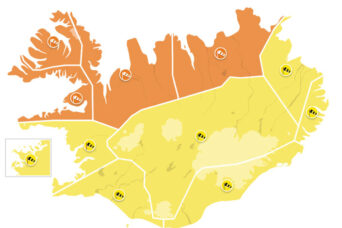
storm weather alerts
Iceland, as an island in the middle of the Atlantic, is highly vulnerable to storms. They can prevent both sightseeing and daily life on the island, but also even just flying in or out of it. Winter storms also often cause huge snowfalls – then getting around Iceland can be locally difficult for up to another 2-3 days.
A major storm can happen in any month, of course, but the phenomena are more frequent from September to March. In autumn (which is somewhat evident from statistics and charts), periods of bad weather are longer, but somewhat milder. In contrast, at the beginning of the year, storms often take a more violent form, although perhaps more often “interspersed” with periods of beautiful, sunny weather. Except that in December and January, the sun comes out over the horizon here only for a short few hours a day.
H
eavy, devastating storms are truly dangerous, but not very frequent. And they are always preceded by an appropriate – yellow or red – weather alert from The Met Office (albeit the alert sometimes comes hours, rather than days, in advance). So don’t let the danger scare you away from Iceland. Just stay alert, follow the weather reports, always be mindful of the wind, drive carefully and – if needed – don’t go to the affected areas or leave them BEFORE the storm arrives.
An additional threat specific to Iceland is volcanoes. The eruption of Eyjafjallajökull in early 2010 paralyzed air travel throughout Europe. In 1996, a volcanic flood – known here as a yokulhlaup – completely destroyed Route 1 on the south coast and the bridge over the Skeidara River In contrast, the latest eruption – known by three names: Fagradarsfjall, Geldingadalir and Maradalir – was purely a tourist attraction and disrupted neither road nor air traffic.
Several volcanoes in Iceland are constantly active. Icelandic services keep track of this activity and warn of danger if necessary. These are not common events (from the perspective of tourists), but they can happen nonetheless.
Do
keep it in mind that your plans can also be thwarted by a volcanic eruption, glacial flood or a major landslide. These are rare phenomena, but they do happen nonetheless.
Winter weather in Iceland
According to Polish criteria, there is basically no winter at all in the south of Iceland, as the average daily air temperature here stays above 0 °C (32 °F) in every month. On the other hand, from November until March there is fairly uniform weather, which can hardly be described as anything other than just winter.

icy Road 1 in winter
Average maximum daytime air temperatures (in the south) from November to March range from 3 °C to 5 °C, and average lowest nighttime temperatures from 0 °C (32 °F) to -2 °C (in November it’s 0.3 °C, but let’s not be petty). During this period we also have few hours of sunshine (less than 3h a day except in March, when it is a bit more), high rainfall (more than 85mm a month) and really strong wind. The average wind strength throughout this period (in Reykjavik) is more than 15 km/h (9 mph), but the average gusts exceed 30 km/h (19 mph) in each month, with the strongest gusts reaching up to 90 km/h (56 mph).
In the north – in Akureyri and Isafjordur – pronounced winter also lasts just from November to March, but it is slightly colder there. Average daily air temperatures then mix between -1 °C and +1 °C, average lowest nighttime air temperatures then drop below 0 °C (32 °F) (but remain above -4 °C / 5 °F), and maximum daytime temperatures are (on average!) between 2 °C (36 °F) and 5 °C (41 °F). As in the south, this is also the period of the strongest winds and high rainfall.
R
emember that statistical averages are not everything. As we pointed out at the beginning of the article, in Iceland individual days very often deviate quite far from the averages. That’s why, for example, winter temperatures of -20 °C (-4 °F) are not unusual in Iceland.
The lowest temperatures recorded in Reykjavik from November to March fall below -10 °C (14 °F), and in the north even to -15 °C (5 °F). By the way, this is the temperature measured according to the world standard, so 1m above the ground. Meanwhile, temperatures at the very ground drop to -20 °C (-4 °F) and beyond during this period, including on the southern coast. Strong winds further intensify the sensation of cold and strongly reduce the so-called “perceptible temperature.
H
ills above Isafjordur are not representative of Iceland as a whole, but as a matter of interest we can report that between 2000 and 2022 in every December, January, February and March the meteo station on Thverfjall hill recorded winds of more than 100 km/h (62 mph) at least once. And in November at least 98.6 km/h (61.3 mph). The wind, of course, loses such hurricane-like momentum going deeper into the island, but strong ones can be anywhere.
From November to March there are many storms in Iceland and, as a rule, snow, which is common everywhere. In the north the snow cover persists throughout the winter, in the south it tends to “appear and disappear.” However, also in the south, after a strong snowstorm, large areas of the country can be cut off from the world for up to several days.
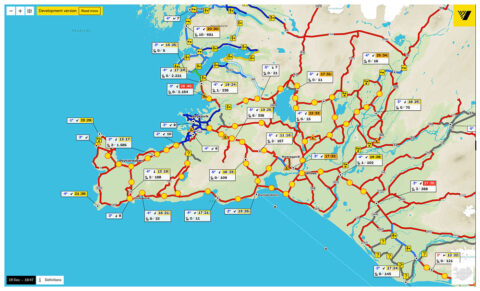
Closed roads in southwest Iceland; December 19, 2022
A snowstorm in December 2022, for example, immobilized the entire southwestern part of the country for as long as three days. Just before Christmas, not only did Keflavik Airport not work, but it was not even possible to come to or from it. Tourists were also ‘stranded’ in Reykjavik itself or at the famous Blue Lagoon, among other places. All roads in the south of the island were then completely impassable for 2 or even 3 days in places. For the Reykjavik area, it was an extremely extreme snowstorm, but in the north of the country, locally, such situations are not some completely exceptional rarity….
T
ypical Icelandic winter is quite mild and not very cold. But when an “Arctic vortex” happens, winter in Iceland can be very tough and dangerous. You can read about how to organize a trip to Iceland in winter and how to prepare for it in this article:
Departure to Iceland in winter.
weather in Iceland in November
We usually qualify November as autumn, but in Iceland it is actually the first winter month. This is especially true in the north of the country. The average daily temperature – even in the north – is still above 0 °C (32 °F) (but below 5 °C / 41 °F), but many days – and especially nights – are already really cold. The minimum air temperature there drops below 0 °C (32 °F), and the strongest frosts reach -10 °C (14 °F).
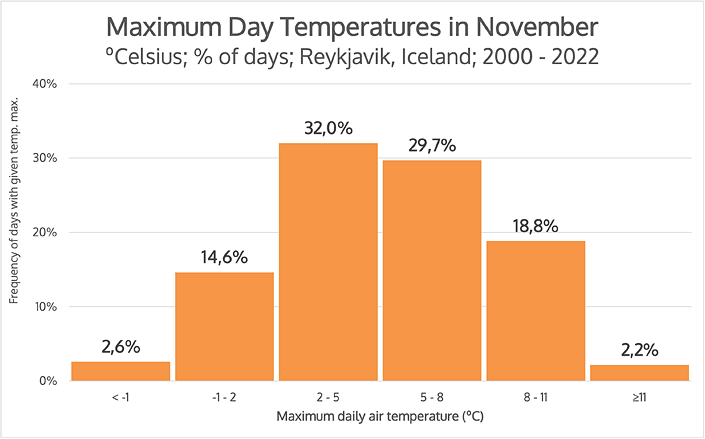
Number of days with a given daily temperature in November.
(max daily temp, Reykjavik, 2000-2022)
In Reykjavik and on the south coast, daytime temperatures hover around 5 °C (41 °F) and more than 60% of days have temperatures between 2 °C (35 °F) and 8 °C (46 °F). Roughly one in five days (21%) has a temperature of 8 °C (46 °F) or higher, but at the same time as many as 15% of days (that is, about 1 in 7) have a temperature of about 0 °C (32 °F) and frosty days are already appearing. Admittedly, this is less than 3% of days, but they can already be recorded. The coldest November night (since 2000) recorded temperatures as low as -15.1 °C (4.8 °F), and as low as -18.5 °C (-1.3 °F) at ground level.

Sunrise and sunset in November
The day also becomes noticeably shorter. In the middle of the month – on November 16 – the sun in Reykjavik emerges from behind the horizon as late as 10 a.m., and sets as early as 4:20 p.m. It is relatively clear (by 6º) above the horizon only from about 12 to 2 p.m. If there are no clouds at the time, it is “as bright as can be” from about 8 a.m. to 5 p.m., but usually, however, it is cloudy, so it is also quite dark.
Precipitation remains at the high level to which it had already grown in September. However, now – combined with low temperatures – snowstorms are also already appearing.
Wind strength is also increasing. Although the highest will not be until February, the average for November – 15.4 km/h (9.6 mph) – is clearly higher than in October, and it will not drop to lower values again until April.
Although snow in November is not yet a regular visitor, especially in southern Iceland, a November completely without snow would be rather strange.
Like September and October, November is also an unpleasant stormy month, but in addition, frosts are already starting then, so conditions for visiting Iceland get really unpleasant.
weather in Iceland in December
The end of the year is cold, windy and snowy (or rainy), like all winter, but the most important feature is the super-short days. The average number of hours of sunshine in December in Reykjavik drops to 0.5 hrs (yes – only half an hour a day, on average for the whole month!), and in the north, in Akureyri, simply to zero. During the winter solstice – December 22 – the sun in Reykjavik begins to rise at 11:23 a.m., but never rises completely and smoothly transitions into sunset, which ends at 3:30 p.m.
Naturally, it is also colder than in November. The average maximum temperature drops to 3.4 °C (38 °F) during the day and -1.6 °C (29 °F) at night.
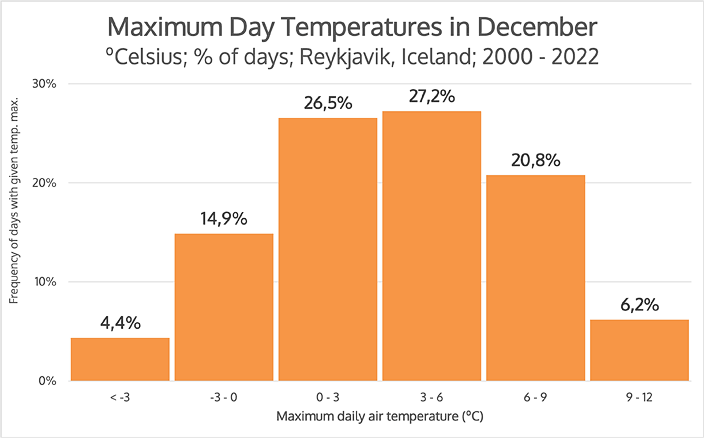
Distribution of daily temperatures in December
(% of days with a given max. daily temp., Reykjavik, 2000-2022)
As you can see on the graph, almost 3/4 (to be exact: 74.5%) of December days have daily temperatures between 0 °C (32 °F) and 9 °C (48 °F), and just over 1/4 (27%) between 6 °C (43 °F) and 12 °C (54 °F). Typically, or most often, December in Iceland is thus NOT very cold, although nighttime temperatures almost always drop below freezing.
However, these relatively warm days are, as it were, offset by perhaps few, but very cold days. For example, on December 30, 2022, the maximum daytime temperature was only -8.2 °C (17.2 °F), and the minimum at night was a record -15.2 °C / 4.6 °F (this was the lowest temperature recorded since 2000). Even lower are the temperatures measured near the ground – here the record belongs to 2/12/2019 and is -20.3 °C (-4.5 °F).
It was also on December 2022 that the aforementioned snowstorm occurred, which cut off all of Reykjavik and Keflavik Airport, among others, for 2 days.
Combined with persistently high precipitation and strong winds, the perceptible temperature is usually really low in December.
As a “consolation,” so to speak, let’s point out that, in turn, the highest temperature recorded since 2000 in Iceland in December was as high as 12 °C / 54 °F (this was on December 6, 2002). So it varies 🙂
weather in Iceland in January

Sunrise and sunset in January
The beginning of the year is of course (still) the middle of winter. What strikes you immediately is the super-short day. The sun doesn’t appear above the horizon until after 11 a.m., but it never rises above 6º and just after 4 p.m. it disappears completely below it again. It is relatively bright between 10 am and 5 pm, but only “relatively” and only if there are no clouds.
January is also a month of very strong winds. The average wind speed in Reykjavik is 16.9 km/h (10.5 mph), but gusts reach up to 76 km/h (47 mph). On the West Fjords peninsula, it was in January that the strongest winds were recorded – the record reading was as high as 236.2 km/h (146.8 mph)!
January is also one of the months with high precipitation totals. If the precipitation hits a low temperature (and it’s easy to do so at night), snowstorms can happen all over the island, even cutting off parts of the island from civilization (usually for the night and morning, but sometimes even for 2-3 days).
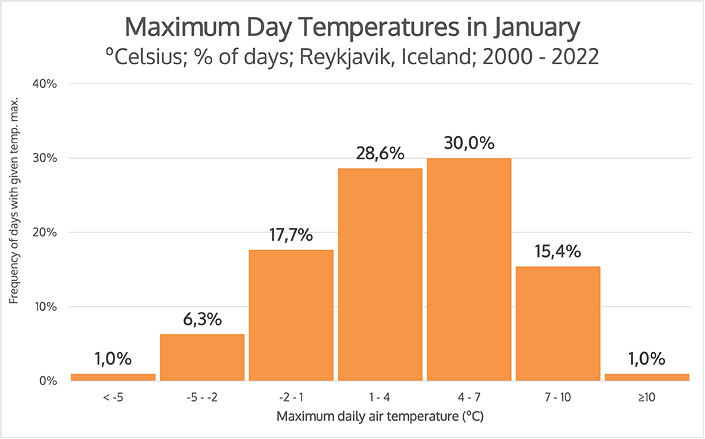
Distribution of daily temperatures in January
(% of days with a given max. daily temp., Reykjavik, 2000-2022)
Typical daytime temperatures for January range between 1 °C (34 °F) and 7 °C (45 °F) (that’s almost 60% of the days), and only on about 2% of the days the temperature drops below -5 °C (23 °F) or rises above 10 °C (50 °F). However, it should be remembered that at night the temperature near the ground sometimes drops as low as -20 °C (-4 °F).
A
verage temperatures in Iceland are rather mild, but extreme conditions, can be truly extreme. Therefore, in January, expect a mild winter, but be prepared for a harsh one, too.
weather in Iceland in February
February is still a winter month, of course, but especially in the south you can already feel spring slowly approaching. Although frost is still standard at night, but on average it is already rather mild – between 0 °C (32 °F) and -3 °C (27 °F). There are, of course, nighttime frosts of around -10 °C (14 °F), but in turn the warmest recorded nights had temperatures even above 7 °C (yes: above +7 °C (44 °F) in February, at night!).
During the day, as in January, about 60% of days have maximum temperatures between 1 °C (39 °F) and 7 °C (44.6 °F), but almost 20% of days have temperatures between 7 °C (44.6 °F) and 10 °C (50 °F), and only less than 5% fall below -2 °C (28.5 °F). In the chart below, you can also see that the days in February split almost perfectly in half between those that record temperatures above and below 4 °C (39 °F).
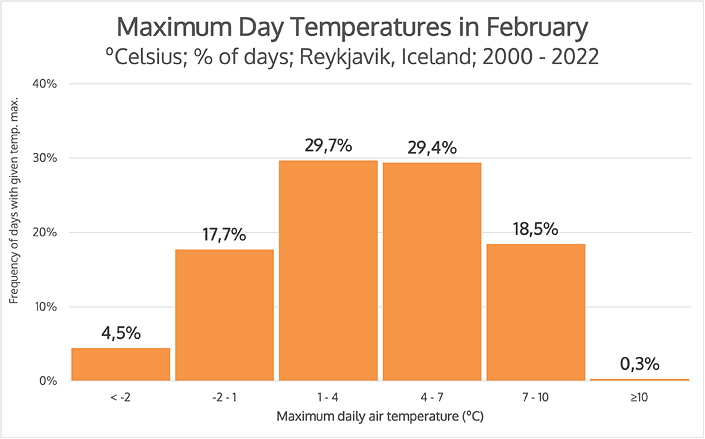
Distribution of daily temperatures in February
(% of days with a given max. daily temp., Reykjavik, 2000-2022)
A
lthough daytime temperatures are usually above freezing, frequent nighttime frosts mean that snow over most of Iceland persists without issue.
In February, precipitation and wind still remain high in Iceland. In the West Fjords, it is even the month with the highest average wind strength. In Reykjavik, too, it was February that recorded the most wind gusts (the average is 33.4 km/h / 20.8 mph). Therefore, even though the temperature objectively may already be completely bearable, the perceived temperature is still, however, annoyingly low, and the risk of a critical weather collapse is high.
Average wind speed on the east coast compared to Reykjavík and the West Fjords;
based on 2000-2022 data from Veðurstofa Íslands, vedur.is
weather in Iceland in March
March in Iceland still has to be considered a winter month. However, the noticeably longer day creates weather that is much milder than in December or January and perhaps optimal for seeing the winter face of Iceland.
If you want to see the aurora borealis and remarkable ice caves then March is perfect time for that.

Distribution of daily temperatures in March
(% of days with a given max. daily temp., Reykjavik, 2000-2022)
The average maximum daytime air temperature in March is already almost 5 °C (4.72 °C (40.5 °F) in Reykjavik, 4.0 °C (39.2 °F) in Akureyri). Days with temperatures over 10 °C (50 °F) are also becoming more frequent, and this is true both in the south and north of the island. However, nights are still cold (average: -2.9 °C / 27 °F, extreme: -16.7 °C / 2 °F), so you can still see snow in most of Iceland in March.
The wind has not yet begun to abate either. Its average speed in both Reykjavik and Isafjordur in the Western Fjords is 16.7 km/ (10.4 mph). And the February record, measured at Thverffjall Hill (Þverfjall) above the aforementioned Isafjordur, is still over 200 km/h (125 mph). So it’s getting brighter and warmer, but still conditions can be very difficult.

Amount of sunshine in March.
In all regions, monthly precipitation also remains high. Only in the north – in Akureyri – in March (as in the entire first quarter) it is noticeably lower than in the last months of the year. However, even there, total precipitation in March (47.7 mm) is almost exactly twice as high as in the following month – April (25.0 mm).
On March 21 comes the vernal equinox, the symbolic first day of spring. The sun rises at 7:26 a.m. and sets more than 12 hours later, as late as 7:46 p.m. Moreover, ‘daytime’, the time when the sun is at least 6º above the horizon, lasts for more than 10 hours (from 8:29 a.m. to 6:42 p.m.), while in December and January ‘daytime’ does not occur at all. With cloudless skies, the weather can be beautiful!.
Certainly in Iceland, March is the last month of relatively stable, but severe, winter weather. Instead, starting in April, dynamic changes begin to shift Icelandic weather into summer modes.
weather in Iceland in spring
From the point of view of a tourist coming to Iceland, April and May should be considered spring here. These are two months of marked change between relatively stable winter weather and another relatively stable summer period. In April and May, on the other hand, all weather factors change very dynamically.
The weather changes in spring are mainly the ever-increasing day length, rapidly decreasing precipitation, decreasing wind speed and increasing temperature – both daytime and nighttime. So all factors are changing in a way that is favorable to tourists.
However, let’s not go into hurra-optimism. In the West Fjords, for example, the noticeably weaker wind means so much that while from November to March we record winds of up to 200 km/h (125 mph), spring records settle only around a “measly” 160 km/h (99 mph). Spring is still a challenging season.
April is rather still too cold and wet for a pleasant visit to the island. Rather too high is then still the chance of snow and/or a strong storm. But in May, tourist traffic clearly begins to increase, and prices usually still remain at or near winter levels. If you’re not afraid of bad weather and/or if you’re lucky, it’s possible to see Iceland very nicely by then.
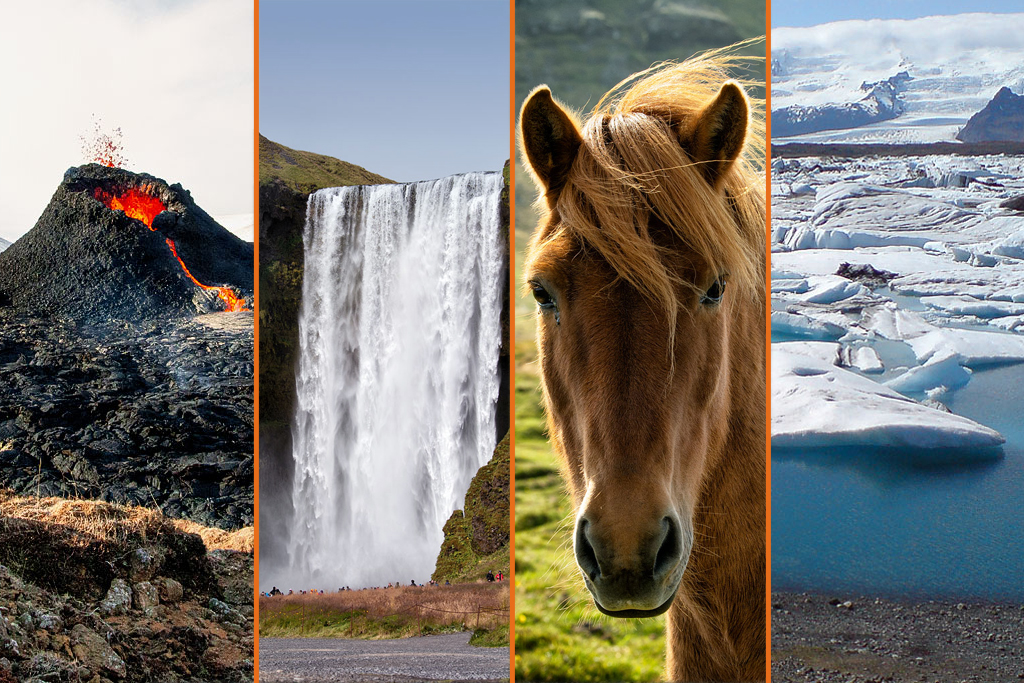
Travel recipe: 7-13 days in Iceland in spring
If you’re considering a spring trip to Iceland, be sure to read our guide to a suggested spring itinerary (along with places to see, hotels to stay inexpensively and plenty of other tips): Iceland spring itinerary: 7 to 13 days.
weather in Iceland in April
As we mentioned above, April is noticeably warmer than March, but nevertheless it is still a cool month. On the other hand, virtually all months are cool in Iceland, so there is nothing to be picky about 🙂
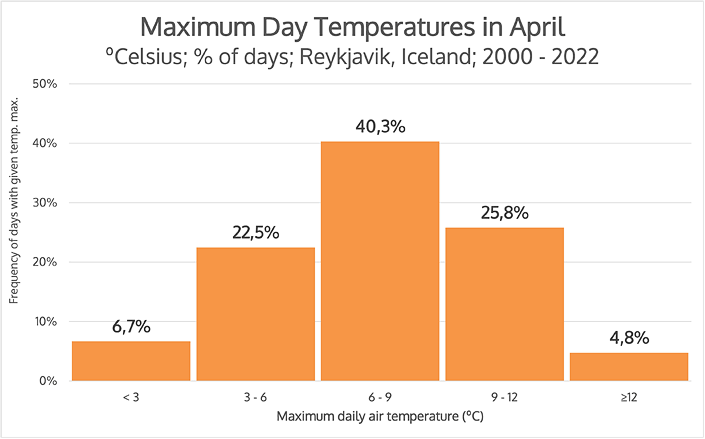
Distribution of daily temperatures in April
(% of days with a given max. daily temp., Reykjavik, 2000-2022)
As you can see, more than 40% of days have temperatures between 6 °C (43 °F) and 9 °C (48 °F), and as many as 88.7% have daily temperatures between 3 °C (37 °F) and 12 °C (54 °F). So it’s clearly warmer than in March, but it’s hard to say it’s warm….
Even in the north – in Akureyri – the average minimum night air temperature is already above zero in April (0.2 °C, but still). And only in the Western Fjords – in Isafjordur – the average night temperature is still ‘in the minus’. But even there this minus is quite symbolic, as it is exactly -0.8 °C (30.6 °F).
Cold records in the West Fjords still have values typical of winter (-13.5 °C / 7.7 °F), but even the average maximum daytime temperature already enters distinctly higher than winter levels: it’s 5.2 °C (41.4 °F).

puffin
In
April puffins return to Iceland.
These charming birds are the country’s icon and one of top tourist attractions. They arrive on the mainland to nest and feed their young. Although they won’t appear “in full strength” until May, you can see them in many places in late April already. Cuteness overload 🙂
In all regions of Iceland, precipitation also drops noticeably in April. In the south, the decrease is still relatively small, but in the north – in Akureyri – April is the first of the three months with the lowest precipitation of the entire year.

In April, the so-called “astronomical night” disappears
The length of the day increases so rapidly that already on April 11, the astronomical night disappears. This means that from that day onward, the sun never for a moment goes more than 18º below the horizon line. From midnight until about 4 a.m., there is the so-called astronomical twilight (the sun is between 12º and 18º below the horizon), but the astronomical dark night will not reappear until September 3….
Wind strength is also weakening. Interestingly, it drops noticeably more strongly in the north and in the West Fjords than in the Reykjavik area. For while in February in both Reykjavik and Isafjordur the average wind speed is 17.4 km/h (10.8 mph), in April it is already 15.8 km/h (9.8 mph) in Reykjavik and 13.8 km/h (8.6 mph) in Isafjordur. The numerical values may not be spectacular, but for Isafjordur this means a drop in average wind strength of just over 20%. This is certainly a noticeable change.
weather in Iceland in May
If you want to see Iceland in relatively pleasant weather and when there aren’t too many people there yet, and the prices for car rentals or accommodations are still reasonably low, May is the perfect month to do so (see Spring trip plan for Iceland: 7 to 13 days).
The average maximum daytime air temperature is already over 10 °C (50 °F) in May, and only less than a fifth of days (17.5%) have a maximum daytime temperature below 8 °C (46 °F). This can be seen in the graph below.
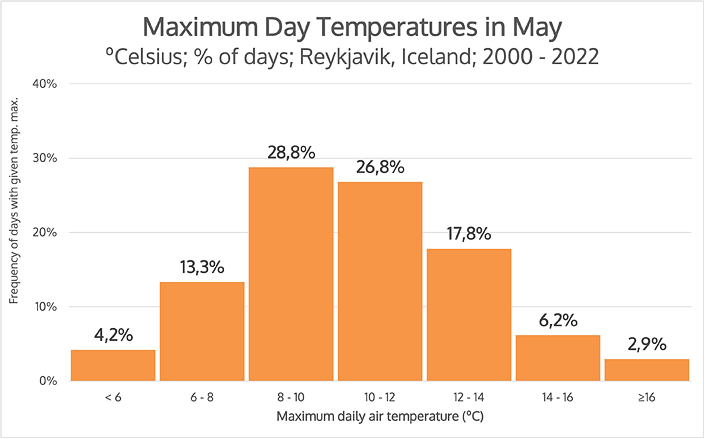
Distribution of daily temperatures in May
(% of days with a given max. daily temp., Reykjavik, 2000-2022)
The above graph – like all on this page – shows data for Reykjavik, but in other regions the situation is very similar. In the north (Akureyri), the average maximum temperature is virtually the same. In the West Fjords (Isafjordur) it is 2 °C lower, and clearly cooler is only the east (Delatangi station), where the average maximum daytime temperature in May is only 6.6 °C (43.9 °F), which is almost 4 °C cooler.
The average minimum temperature at night in the south is 4 °C (39 °F), in the north 3 °C (37.4 °F), in the east 2.3 °C (36.1 °F), and the coldest according to this statistic is in the West Fjords: 1.8 °C (35.2 °F).
It’s even colder in the interior (an average of 5.7 °C (42.3 °F) during the day and -1.3 °C (29.7 °F) at night), but the interior is still closed to tourists in May, so we only give this as a curiosity.
In conclusion, taking strictly daytime air temperatures alone, May in Iceland already gives the impression of a pretty nice early spring month. And this is somewhat true, but with two caveats.
- First: although the wind is already noticeably weaker than in winter, the so-called “wind chill factor” is always high in Iceland – even if it is lower than in winter; if you find a place sheltered from the wind, it can be very nice and pleasant there; but most places in Iceland are not sheltered and the weather impression is quite cold;
- Second: unfortunately, there are weather breakdowns throughout the year. A storm that comes from the north and brings Arctic air can “reverse” the weather for a few days even to completely winter weather. Most days will not be like this, but some as much as possible.
L
et us reiterate an earlier caveat: the average temperature in May is 10.2 °C (50.4 °F), more than 80% of days have temperatures above 8 °C (46 °F), and the warmest days of May even exceed 18 °C (65 °F). But when the weather breaks, it can be (for several days) much colder! The coldest days in May do not exceed 2 °C (34 °F) during the day, and at night the temperature at ground level can drop even below -10 °C (50 °F) Standard, typical weather is one thing, but if you are out of luck, the weather can be worse than in January…
Precipitation in May in virtually all regions of Iceland is at its lowest annual level. However, for some regions it is still high. For example, the station in Delatangi in the east records an average of 112.4 mm of rain in May, which is just one of the lowest results for that station. But at the same time, it is more than the meteo stations in Reykjavik or the West Fjords record in any month of the year… That’s the East for you…
The wind in May is already much weaker in all regions, compared to winter conditions. However, it is still weakening and will only reach its minima in late summer.
Camping weather in Iceland in May
M
ay under a tent in Iceland is still very challenging. It can be nice and warm in the day, but it can be close to winter, too, especially at night. Be very well prepared if you choose to go for this.
Many people ask and wonder if it’s a good idea to go to Iceland in May, and sleep in a tent. It’s cheaper that way, of course, and most campgrounds are already open in May. In addition, in most of Europe May is already very warm, and as you can see from the chart above, Iceland is also “survivable.” If you want to sleep in a tent, however, be prepared for a different kind of weather.
For those thinking about Iceland in May with a tent, we have collected data and prepared a graph showing the minimum temperature at night, at the ground level – see the blue graph below.
By default, the air temperature around the world is measured 1 m above the ground – that’s the standard we’re all accustomed to. But the temperature at the ground level, can differ from this quite significantly. And indeed – night temperatures near the ground in May in Iceland look quite different than the maximum daily temperature chart might suggest. See for yourself:
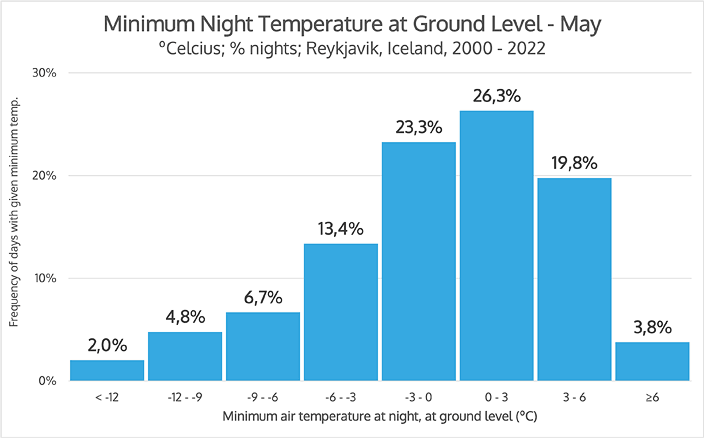
Distribution of minimum air temperature at ground level in May
(% of nights with given min. temp., Reykjavik, 2000-2022)
What do we see in the graph above? Well, among other things, that only half of the nights pass with temperatures above zero (to be precise, even the “lesser half” – 49.9% 😉 ). Half of the nights bring a ground frost, and 1/7 of them (13.5%) frost at -6 °C (21 °F) or stronger. The temperatures can even go below -12 °C (10.4 °F)!
It
is significantly more likely (13.5% vs 3.8%) that the air temperature at ground level will drop below -6 °C (21 °F) at night, than that it will stay above 6 °C (43 °F). So as stated before – go camping only if you’re well equipped and know what you’re doing.
For the sake of completeness: the average minimum temperature at night (measured in the standard way, i.e. 1 m above the ground) is 4 °C (39 °F) in May, with the highest recorded at 11 °C (52 °F) and the lowest at -5.9 °C (21.4 °F). So these are higher indications, but still rather low.
In
May we still recommend accommodation in hotels, hostels or guesthouses. Sleeping in a campervan with webasto admittedly provides comfort, but it will not necessarily be cheaper. In an “RV” with a tent on the roof, you have to expect to spend the night in the cold. And it really is still far too early to pitch a tent on the ground.
May in Iceland already offers plenty of sunshine and often really nice, warm temperatures. However, the wind can still be annoying (or dangerous, even) and the nights very cold. This is the beginning of the tourist season, but not yet the beginning of summer….
Summer weather in Iceland
Summer (the period from June to August) is certainly the best time to visit Iceland. Admittedly, there are the most tourists here then, so the prices are also the highest, but the weather is by far the most pleasant, and on top of that, it’s the only period when you can visit the extraordinary interior (see, for example: Most Interesting Places of the Icelandic Interior).
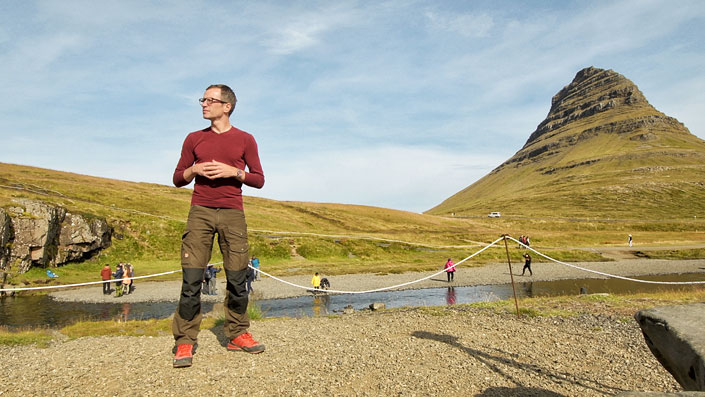
A warm August day in Snaefellsnes
The main features of summer weather in Iceland are the weakest wind, the lowest rainfall totals, the longest days and most hours of sunshine and, naturally, the highest temperatures.
Of course, one must make allowances for the fact that this is Iceland after all. So, for example, a distinguishing feature of the high summer temperatures is that only in these three months did the minimum night air temperature never (between 2000 and 2022) fall below 0 °C (32 °F). The cold record for June was just 0.0 °C (32 °F), for August 2.7 °C (36.9 °F), and for July 3.4 °C (38.1 °F). This is what “warm” means in Iceland 😀 .
For the sake of balance: the three summer months are also the only months in which the maximum daytime temperature above 20 °C (68 °F) was recorded at least once (between 2000 and 2022). The warmth record (for the time being, as climate warming continues) was set on July 30, 2008: it is 25.7 °C (78.3 °F). However, the average maximum daily temperature exceeds the 15 °C (59 °F) mark only in July, and really by a hair’s breadth: it is exactly 15.1 °C (59.2 °F).
C
ompared to the weather central Europe, Icelandic summer is more like a kind of late, warm spring than an actual summer. Even in the warmest month – July – the average maximum temperature is only 15.1 °C, and the average minimum temperature is only 9.3 °C. In addition, there is still quite a strong wind.
Concluding, here’s a “summary of summer” in Iceland:
- Average maximum daytime temperatures range from 13.4 °C (56.1 °F) in June, through 14.5 °C (58.1 °F) in August, to 15.1 °C (59.2 °F) in July.
- The highest temperatures recorded exceed 20 °C (68 °F); are respectively: 22.4 °C (72.3 °F) in June, 24.8 °C (76.6 °F) in August and 25.7 °C (78.3 °F) in July.
- The average minimum night temperature even in summer does not exceed 10 °C (50 °F). That’s exactly 7.5 °C (45.5 °F) in June, 8.8 °C (47.8 °F) in August and 9.3 °C (48.7 °F) in July.
- Summer is the only three months when Iceland (in the south and around Reykjavik) does not record frost, although it is not far from that. The lowest temperatures recorded between 2000 and 2022 are: 0.0 °C (32 °F) in June, 2.7 °C (36.9 °F) in August and 3.4 °C (38.1 °F) in July.
- However, even in summer there are so-called “ground frosts.” The distinguishing feature of the summer months in this regard is that (unlike any other month!) summer frosts do not fall below -10 °C (50 °F). The lowest recorded temperatures at ground level are respectively: -8.4 °C (16.9 °F) in June, -4.6 °C (23.8 °F) in August and -4.1 °C (24.6 °F) in July.
- The interiors are noticeably cooler than the statistics given above, as they almost entirely lie above 500 meters above sea level. Weather in the interiors is dedicated to a separate section of the article Weather in different regions of Iceland.
Summer is also the period of lowest rainfall (45 mm to 60 mm). In the north it’s even less (just less than 20 mm in July), but for the sake of balance in the east, the driest month is June, which records 88.6 mm. Just a reminder that this result – although a record low for eastern Iceland – is still higher than almost every month in Reykjavik….
In summer we can also count on the weakest wind (even “only” 10.9 km/h (6.8 mph) on average for the whole month). But again – in the particularly windy Western Fjords, the lowest monthly average is almost twice as high: 18.7 km/h (11.6 mph; in the hills above Isafjordur). At the same time, the aforementioned Thverfjall hill never (between 2000 and 2022) recorded a month without winds exceeding 60 km/h (37 mph)! (and super strictly: 59.8 km/h / 37.16 mph).
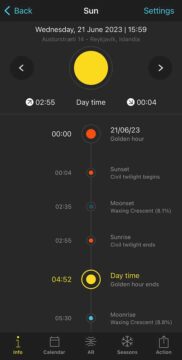
Golden hour all night
Summer, is also the time of “white nights” June, of course, reigns supreme in this statistic. During the summer solstice – June 21 – there is not only night, but even true darkness. The sun partially hides behind the horizon a moment after midnight, but emerges from behind it as early as 3 am. All this time there is the so-called golden hour, that is, the period when the sun does not go more than 4° below the horizon. De facto you can see it at least a little all the time, and during this period “eye flaps” really come in handy – A convenient blindfold, allowing you to sleep even when it’s light out.
Perhaps surprisingly, summer, quite like winter, is a period of relatively stable weather in Iceland (statistically speaking). The individual months don’t vary that much here, although June is certainly the coolest, though, and it can already be more rainy in August. Since this is the most touristy, popular time of year, let’s take a separate look at the weather in each of the summer months.
For those particularly interested in, for example, the weather in the West Fjords or the interiors, once again, check out a separate article just about the weather in each region: Weather in different regions of Iceland.
weather in Iceland in June
June is the first month with an average daily temperature exceeding 10 °C (50 °F). Recall that if a month wants to be considered summer, then its average daily temperature must exceed 15 °C (59 °F). Icelandic June (but also July and August) is therefore quite a lot short of this…
Nevertheless, in Iceland, June is summer, because the average maximum daytime temperature is “as high as” 13.4 °C (56.1 °F), and almost the entire month (93.8% of days) reaches a maximum daytime temperature of 10 °C (50 °F) or more. See graph:
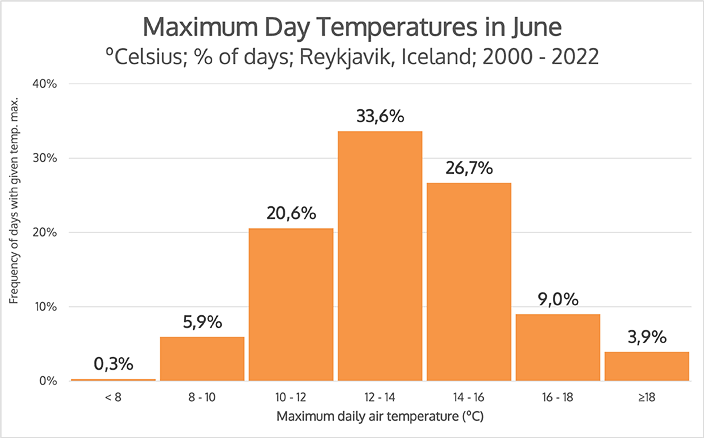
Distribution of daily temperatures in June
(% of days with a given max. daily temp., Reykjavik, 2000-2022)
The average maximum temperature of June is 13.4 °C (56.1 °F) and indeed the temperatures of the entire month ‘oscillate’ around this value. As many as 80.9% of days reach a similar temperature – between 10 °C and 16 °C (50 °F and 61 °F).
E
ven in the interiors, the average maximum daytime temperature exceeds 10 °C (50 °F) in June, as it is 11.2 °C (52.2 °F). This is also the first month of the year when the average minimum temperature (at night) there exceeds zero: it is exactly 3.2 °C (37.8 °F). Summer in full swing! 😉
June – like all summer – is also the period of lowest rainfall. Everywhere, except the interiors, it is the month with the lowest rainfall, although this means something “slightly” different for each region. This record-low rainfall in the West Fjords is 18.1 mm, in the north – in Akureyri – it’s 19.8 mm, and in the south and around Reykjavik: 45.7 mm.
By contrast, in the east (Delatangi station) the least rainy month records as much as 88.6 mm anyway. It may be worth adding that in that region it is the only month with an average rainfall of less than 100 mm, while the other regions mentioned never exceed this limit….
June is also already a month of relatively weak wind. Although in most regions it will still be at least a little weaker in July, but it is still weaker everywhere than in May, and even 30-40% weaker than in the record winter months.
However, let’s remember the right scale. In the West Fjords, for example, June is not only the month with weak average winds, but also the month with the lowest wind speed record. This record for June is exactly 129.6 km/h (80.5 mph). That’s almost twice as low as the January record (236.2 km/h / 146.8 mph), but still, a month of low winds in which we can be almost certain not to exceed 130 km/h (80 mph) prompts us to curb our optimism somewhat in this regard…
Max wind strength in the West Fjords (Þverfjall)
Based on 2000-2022 data from Veðurstofa Íslands, vedur.is
weather in Iceland in July
Looking only at the weather, July is certainly the best month to visit Iceland. Virtually every region then has the lowest (or at least very low) rainfall, the weakest wind, a very long day, and, well, the highest temperatures.
As we mentioned earlier: the average maximum air temperature in July is a record 15.1 °C (59.2 °F). And a little more than 1/3 of the days actually pass at a very similar temperature, with more than 80% between 12 °C (53 °F) and 18 °C (64 °F). So by most European standards it’s a “moderately warm spring,” but Icelanders already turn their air conditioning on 😉
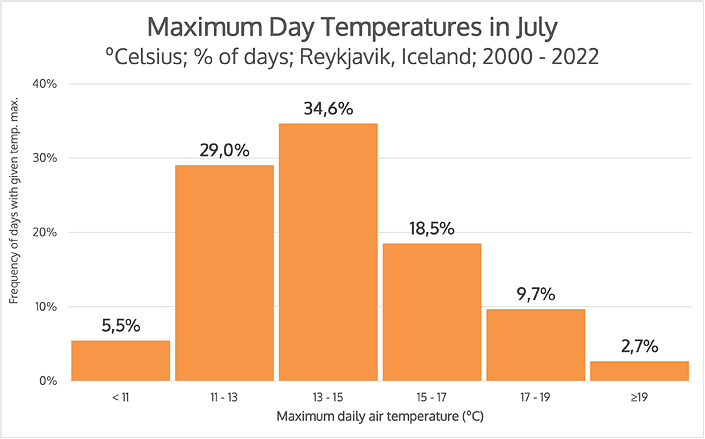
Distribution of daily temperatures in July
(% of days with a given max. daily temp., Reykjavik, 2000-2022)
The record high recorded temperature in July was the aforementioned 25.7 °C (78.3 °F), but in general, temperatures above 20 °C (68 °F) are rare – on average on less than 3% of days, so (statistically) less than once a month.
Other regions of Iceland record temperatures quite similar, mostly 1 °C/F to 2 °C/F lower. Surprisingly, the record-holder in this infamous respect is not the interior (there the average daytime temperature is 13.2 °C (55.8 °F) in July), but the east! The meteo station in Delatangi in July records average maximum air temperatures of only 11.3 °C (52.3 °F)! We have posted detailed weather information for each region in a separate article: Weather in different regions of Iceland.
July – like all summer – offers relatively low rainfall Only in the north – in Akureyri – is it noticeably more than in earlier months, and in the east even more than in February (but the east in general is the rainiest).
In virtually all regions, it is also in July that we record the lowest average wind strength. In the north it’s 10.8 km/h (6.7 mph), around Reykjavik: 10.9 km/h (6.8 mph), in the east 16.9 km/h (10.5 mph), in the interiors 18.3 km/h (11.4 mph), and in the West Fjords 18.7 km/h (11.6 mph). Stronger wind gusts can – and do – happen everywhere, but this is still certainly the calmest month in this regard.
Camping weather in Iceland in July
In July, campgrounds are in full bloom in Iceland, and many people choose to sleep under a tent. This is very sensible, because in summer the costs of car rentals and accommodation are highest, and sleeping in a tent allows you to reduce them sharply.
However, when planning a tent overnight stay, there are three main challenges to keep in mind:
- Most campsites are simply grassy campgrounds. They can be very waterlogged when it rains and soon after. You need to carefully choose where to pitch your tent and make sure you have shoes that are not afraid of water.
- Nights are bright and windy. You really need a blindfold in your tent, and many people also find earplugs useful. Campsites in the lowlands are (usually) not badly sheltered from the wind, but in the interiors, it even happens that the wind simply tears up weaker or less well pitched tents
- Summer in the Icelandic edition is not very warm. In the interiors it can always snow, but even outside you have to expect really cold nights. More than 3/4 of the nights pass with a minimum temperature between 7 °C and 11 °C (44 °F and 52 °F), but temperatures near the ground drop much more: more than 90% of the nights “pass” below 9 °C (48 °F), and almost 10% below 0 °C (32 °F). See the chart below.
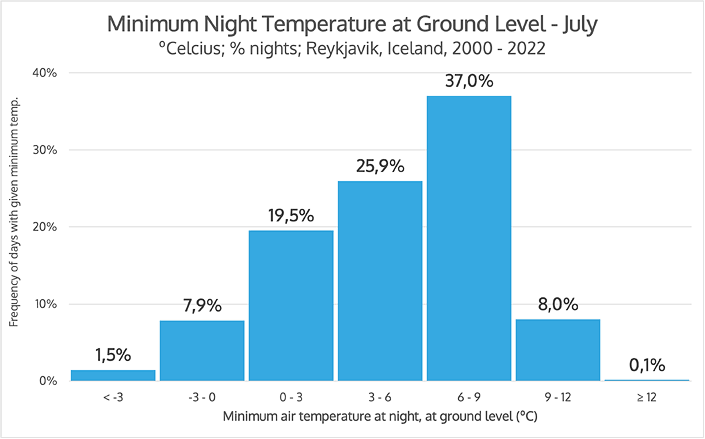
Distribution of minimum air temperature at ground level in July
(% of nights with given minimum temp., Reykjavik, 2000-2022)
As you can see above, although most often the temperature at ground level falls “only” to between 6 °C and 9 °C (43 °F and 48 °F), unfortunately as many as almost 30% of nights record a ground temperature below 3 °C (37 °F). This will be especially true for the interior, where you can absolutely expect snow and night frosts at any day of the year.
Keep in mind that this is data for Reykjavik, quite accurately representative of the entire southwestern region of Iceland. In other areas, as we wrote above, it is similar, but nevertheless usually about 1 °C to 2 °C cooler, so those 30% of nights there may already record temperatures around 0 °C (32 °F).
T
he minimum temperature, measured traditionally – i.e., 1 m above the ground – in July for all regions of Iceland averages between 7 °C and 9 °C (44 °F and 48 °F). But the temperature near the ground is noticeably lower, and it does occasionally drop below freezing even in July.
T
he best time to go trekking in Iceland is in July, but still be sure to bring warm clothing, a sturdy tent and a gas stove that is not afraid of the wind – preferably the JetBoil type.
weather in Iceland in August
August is certainly a summer month in Iceland, but already with a distinct “stamp” of autumn. In some regions, it’s still very much a summer month, but in others, it’s already clearly more autumnal.
August is the last of the three months with an average daily temperature of more than 10 °C (50 °F) (to be precise: 11.3 °C / 52.3 °F). The average maximum daytime temperature then is 14.5 °C (58 °F), and the average minimum at night: 8.8 °C (48 °F). It is also the last of the three months when frost does not occur in Iceland (outside of the interior and highlands, of course).
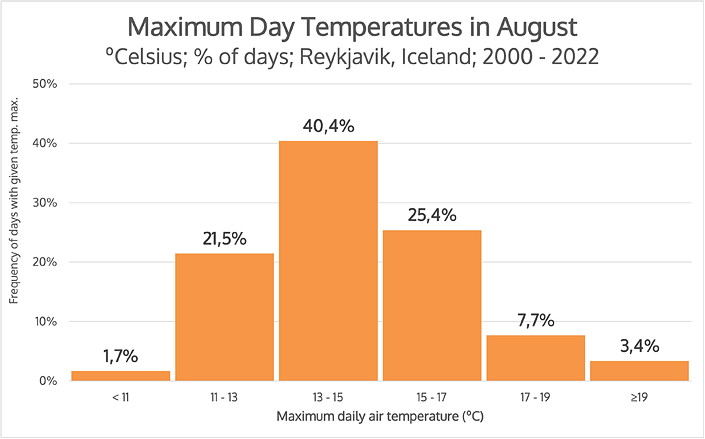
Distribution of daily temperatures in August
(% of days with a given max. daily temp., Reykjavik, 2000-2022)
As you can see on the chart, about 40% of days pass in Iceland in August with maximum temperatures between 13 °C and 15 °C (55 °F and 59 °F), with a huge majority – 87.3% – falling somewhere between 11 °C and 17 °C (52 °F and 63 °F). The lowest temperature recorded in recent years was 2.7 °C (36.9 °F), and the highest: 24.8 °C (76.6 °F). A little over a third of days (36.5%) bring a maximum temperature of 15 °C (59 °F) or higher. And so in Iceland August certainly passes as a warm summer month ?♂️
The lowest average maximum daytime temperature is measured at the eastern station in Delatangi (11.6 °C / 52.9 °F), and not at stations in the interior (12.0 °C / 53.6 °F) nor in the West Fjords (12.8 °C / 55 °F). This is also a sign of summer, because August is the warmest month of the year in the east.
Of course, this is weather information for the lowlands and the ‘general’ highlands. If you drive or hike higher – such as to the Askja crater – you may well find yourself in winterland already.
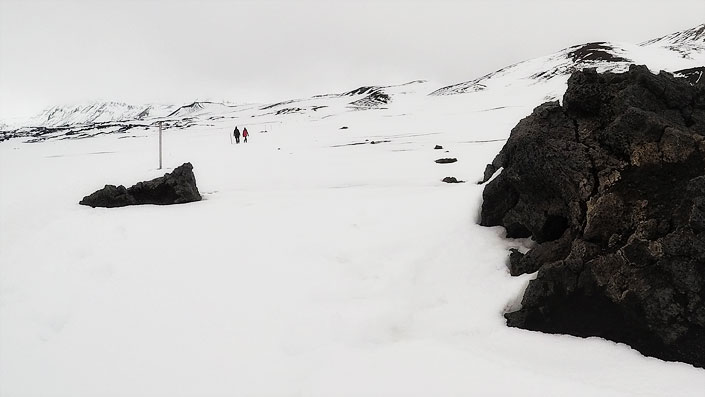
Path to Viti Crater (Askja, August 2019)
As for night temperatures, here the interior is already back in first place (from the end, in a sense). In August, the lowest average minimum temperature at night was 4.4 °C (40 °F) as measured at the Veidivatnahraun station in the interior. This is a distinct few degrees less than the same measurement for all other regions, including in particular the Reykjavik area, where, as we mentioned above, it is 8.8 °C (47.8 °F). The distribution of temperatures near the ground is very similar, almost identical to July’s, shown above.

The hours of sunrise and sunset in August
August – like all summer actually – is also the period between the summer solstice and the autumn equinox. So the day becomes shorter and shorter, but nevertheless it is still long. In the middle of the month – August 16 – sunrise occurs at 5:21 am and sunset at 9:41 pm. With ‘daytime’ – the period when the sun is more than 6º above the horizon – lasting from 6:32 am to 8:30 pm.
August is also the last month with low winds (although as far as these factors are concerned, regional differences begin to play a bit more of a role). The West Fjords even once had an August in which the wind speed did not exceed 60 km/h (37 mph) on a single day, which is a complete rarity for the region. For comparison: there has not yet happened a January there, when speeds of more than 120 km/h (75 mph) would not have been recorded there….
In the Icelandic interiors, August is the month with the lowest precipitation (an average of 51.3 mm), but in all other regions it is already significantly higher than in May and June, although still far below the winter and – a record in this regard – autumn. For the Reykjavik area, it’s 61.2 mm, compared to 45.7 mm in June and 80 mm to 100 mm from September to March. In other regions, the correlations are similar, although the indication values themselves are different. In the record-breaking rainy east, August already records 135.9 mm of rain, but there, too, that’s far less than will fall in September or January, and especially in the record-breaking October there.
On
Icelandic lowlands, August is still summer, even if the nights are sometimes cool. But in the interior and in the mountains, the weather can already be quite wintry.
In the second half of August, puffins also begin to depart from Iceland. They will spend the winter off the mainland – feeding in the cold waters of the North Atlantic.
Autumn weather in Iceland
Autumn in Iceland, like in Poland, sometimes begins as early as the end of August, and sometimes not until somewhere in mid-September. Temperatures (especially at night) drop, the wind blows harder and harder, and it rains more often, and harder. The day becomes not only colder and colder, but also wet, short and increasingly dark.
The storms are also already starting to get stronger. Although winter is considered the main storm season, the last famous storm – one that took off the roofs of houses, broke windows (including in cars) and moved cars across parking lots – happened in September. More specifically: September 25, 2022 in northeastern Iceland. See the article here: East Iceland Battered By Storms, Extensive Damage
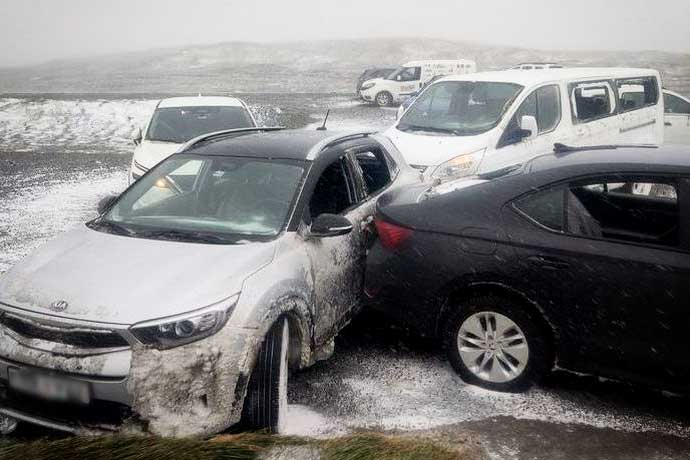
“Eastern Iceland under storm pressure”
(article in Reykjavik Grapevine)
Prices for many services also drop noticeably in autumn, but tourists are fewer and fewer anyway. The weather does not inspire for sightseeing nor visiting Iceland at all. Mountain roads (marked F) and most campgrounds are being gradually closed. In the second half of September, the last of the mascons are also leaving Iceland. Many whales are also leaving the coastal waters. They swim further south, toward the Caribbean, to give birth and feed their young. Winter is coming…
It is worth noting that autumn, like spring, is, at least from a tourist point of view, a shorter season than winter and summer, because it lasts only two months. August is still warm enough to rather match summer, but November is already cold and rainy and snowy enough to make it realistically a winter month. Therefore, autumn, is actually only September and October. Two months when Iceland returns from its relatively warm and welcoming state to winter weather that is as stable as it is unpleasant.
Autumn is characterized by similar temperatures and wind strength as spring. The main difference between these seasons is the amount of precipitation. While it is relatively low in spring, it breaks records in all regions in autumn. For parts of Iceland, September is the rainiest, and for the rest, October. Naturally, in the east these rainfall records are about twice as high as anywhere else in the country.
A
utumn is the worst time to visit Iceland. The weather is very unpleasant, with strong storms becoming more frequent. And at the same time, it is still too early for most of the typical winter attractions (aurora borealis, ice caves).
What is the weather like in Iceland in autumn? Here is a brief summary of it:
- Average maximum daytime air temperature ranges from about 6 °C (43 °F) in the north and West Fjords, to about 11 °C (52 °F) in the east and south. In the interiors it drops to 3 °C (37 °F), but the interior is off-limits to tourists by then.
- The average minimum night temperature in the interior already drops below 0 °C (32 °F), but in the lowland parts of the country it records from about 1 °C (34 °F) in the north and Western Fjords, to about 6 °C (43 °F) in the south and east.
- Autumn – like any season – on individual days can deviate very strongly from the averages indicated above. The highest temperature recorded then is as high as 24.1 °C (75.4 °F) (east – Delatangi meteo station), and the lowest: -10.9 °C (12.4 °F) (north – Akureyri), with frosts as low as -14.6 °C (5.7 °F), and even stronger in the interiors (-18.1 °C / -0.6 °F).
- Record high rainfall in autumn, although it reaches different values for different regions. For most regions it ranges from about 75 mm to 100 mm, but in the record-breaking east in this regard it is even as high as over 200 mm!
- Very quickly in autumn, the average wind strength in Iceland also increases, and in all regions it reaches at least 80% of the maximum: from 10.6 km/h (6.6 mph; north, Akureyri) to as much as 22.9 km/h (14.2 mph; interior).
- In early autumn, sunrise ends around 7:30 a.m., and sunset begins as early as approx. 7:30 p.m. At the end of autumn (late October), it’s around 10:30 a.m. and 4 p.m. respectively.
weather in Iceland in September
Autumn begins in Iceland in the main with an increase in wind strength and rainfall.
Winds in the south and Reykjavik reach an average of about 14 km/h (8.7 mph), which is about 30% more than in the calmest month – July – although still about 20% less than the windiest month – February. In other regions, the correlations are very similar, although the average wind speed itself can vary somewhat.
Rainfall totals rise from a moderate 61.2 mm by as much as more than 60%: to a record 98.9 mm. In the east, September precipitation totals are as high as 165.3 mm, although for that region this is not (yet) a record.
Maximum daily temperatures are clearly dropping, but still usually stay above 10 °C (50 °F) – see chart.
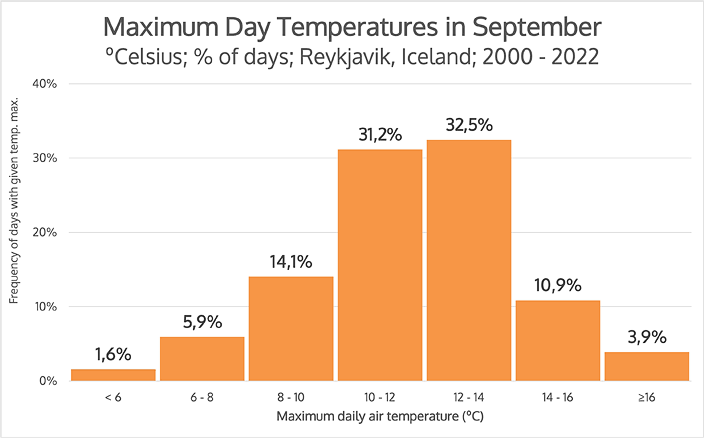
Distribution of daily temperatures in September
(% of days with a given max. daily temp., Reykjavik, 2000-2022)
More than 60% of days in September have a temperature close to 12 °C (54 °F), and almost all (88.7%) are between 8 °C (46 °F) and 16 °C (61 °F). This is, of course, quite a wide range, but still does not include extremes. The highest air temperature measured in September reached 18.5 °C (65.3 °F), but the coldest day did not even exceed 3.5 °C (38.3 °F) (sic!).
The average of the minimum night temperatures was 6.4 °C. The warmest September night recorded as much as 13.4 °C, but the coldest night already a clear frost: -3.4 °C (26 °F). Minimum temperatures at ground level averaged 3.3 °C (38 °F), but have already dropped as low as -10 °C (50 °F) (14 °F). The record “frost” was as low as -11.9 °C (10.6 °F).
September 23 marks the autumnal equinox. After that, the night is again longer than the day and its length increases quite rapidly in Iceland.
weather in Iceland in October
October is another transitional month in Iceland, after September, but still warm enough to hardly be called winter. Wind and precipitation are already at high levels, just characteristic of winter, but the average maximum temperature during the day is still above 5 °C, and the night temperature is above 0 °C (32 °F). So winter is still a tad away, although the weather really is far from “cool.”
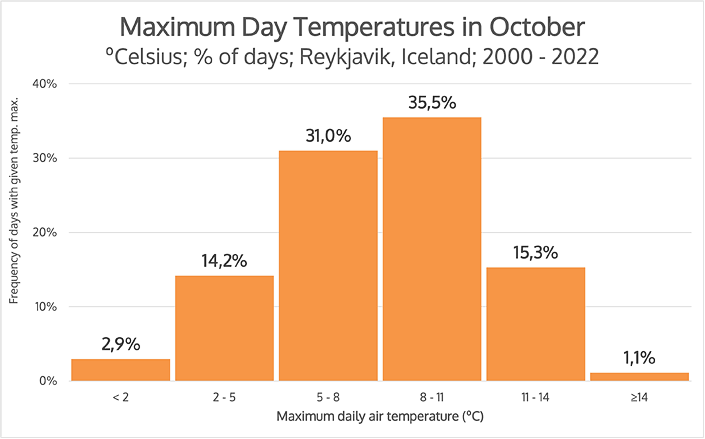
Distribution of daily temperatures in October
(% of days with a given max. daily temp., Reykjavik, 2000-2022)
The average maximum daytime temperature is 7.9 °C (46.2 °F) in October. Nearly 2/3 of days (66.5%) pass with temperatures between 5 °C (41 °F) and 11 °C (52 °F).
Frost during the day (as a maximum temperature) is rather rare, but at night it is already the norm. Even the average minimum temperature at night already falls a tad below zero – it is -0.2 °C (32 °F).
M
aximum temperature recorded in October was 15.6 °C (60 °F), but the lowest was -7.2 °C (19 °F), and at ground level it was only -14.6 °C (6 °F)!
In many regions, rainfall totals are slightly lower in October than in September (and lower than in winter), but in the rainiest eastern region, October is the rainiest month of the year. For the years 2000-2022, the average rainfall in October was as much as 208.8 mm in the east (see the distinct ‘hill’ on the right of the chart below). For many regions of Europe this is a six-month norm!
Average monthly precipitation on the east coast compared to Reykjavik and North Iceland
based on 2000-2022 data from Veðurstofa Íslands, vedur.is
October is also the most “wet” month in the north (Akureyri), but there this rainiest of months received only a “measly” 78.8 mm of precipitation.
Wind is also increasing in all regions of Iceland, but nowhere as high as it will be in the winter months. For the oft-mentioned Thverfjall station in the hills above Isafjordur, the strength of the October wind (27.9 km/h / 17.3) is almost 50% more than in July (18.7 km/h / 11.6 mph), but at the same time also almost 50% less than in January (34.1 km/h / 21.2 mph). So it’s already really windy, but “it’s not there yet”.
Summary
So when is the best weather to visit Iceland? Strictly speaking, it will certainly be the holiday season. However, if you don’t care about visiting the interior and want to avoid the highest prices, May and June will be the best.
On the other hand, for seeing the aurora borealis, ice caves and the beautiful winter landscape, February and March will certainly be the best, although you have to be lucky then not to hit one of the storms. And only autumn is the period that is actually best avoided.
We write more about which time of year to choose for a trip to Iceland, how to arrange your entire trip then, and in particular what to see, where to sleep, what car to rent and how to build your itinerary in the article When (and how) it’s best to go to Iceland You’ll also find links to suggested detailed itineraries, showing routes and places worth visiting for longer and shorter trips.
Resources
- Einarsson, Markús Á.: Climate of Iceland, in H. van Loon (editor): World Survey of Climatology: 15: Climates of the Oceans. Elsevier, Amsterdam, 1984, pp 673-697.
- Icelandic Met Office Climatological data.
Meteograms of selected weather stations



